Key Conclusions
1. According to detailed calculations by Carbonstop, China's e-commerce sector emitted 53.26 million tons of carbon in 2019. This is expected to continue growing rapidly, with emissions projected to reach 116 million tons by 2025.
2. The main sources of carbon emissions from China's e-commerce sector include: packaging (approximately 18%), logistics (approximately 29%), office operations (approximately 26%), data centers (approximately 23%), and warehousing (approximately 4%).
3. Sources of carbon emissions from online shopping include: transportation - courier delivery (approximately 29.16%); buildings - office operations (approximately 26.12%); buildings - warehousing (approximately 3.88%); information technology - data centers (approximately 22.78%); information technology - consumer device power consumption (approximately 0.02%); packaging - courier packaging (approximately 18.04%).
4. Sources of carbon emissions from offline shopping include: transportation - pre-store delivery of goods (approximately 13.03%); transportation - consumer travel emissions (approximately 35.87%); buildings - store operations (including office operations) (approximately 47.11%); packaging - plastic bags (approximately 1.05%).
5. According to research and calculations by Carbonstop, online shopping is more carbon-efficient than offline shopping. The carbon emissions for purchasing a single item online and offline are 1094.92gCO2e and 1360.24gCO2e, respectively.
In recent years, with the continuous development of e-commerce, its scale has expanded significantly, playing an increasingly important role in the national economy and penetrating deeper into residents' daily lives. However, this rapid growth has also brought a series of environmental and energy issues.
Data Source: National Bureau of Statistics
China has announced that it will peak its carbon emissions before 2030 and achieve carbon neutrality before 2060, making "carbon peaking and carbon neutrality" one of the eight key tasks for 2021. Therefore, how much impact does e-commerce have on carbon emissions, and how can it contribute to achieving "carbon peaking and carbon neutrality"? According to the CREO carbon neutrality pathway proposed by the Carbonstop team, the first step is to quantify its own carbon emissions, i.e., Calculating (计算). Only after understanding the current emission status can appropriate emission reduction actions be taken to lay a solid foundation for achieving carbon neutrality.
Recently, the Carbonstop team conducted an in-depth study of e-commerce companies, evaluating the total carbon emissions of e-commerce and comparing the carbon emissions of online and offline shopping. They released the "Total Greenhouse Gas Emissions Report for Chinese E-Commerce Companies" and the "Comparison Report on Greenhouse Gas Emissions Between Online and Offline Shopping."
Total E-Commerce Carbon Emissions Assessment
The total assessment primarily evaluates the carbon emissions from five areas: packaging, logistics, data centers, office operations, and warehousing. The study found that e-commerce generates 53.26 million tons of carbon emissions annually, accounting for 2.5% of the total emissions from the tertiary sector. It would require approximately 10 billion trees to offset these emissions. Specifically, logistics account for 15.54 million tons (29%), office operations for 13.92 million tons (26%), data centers for 12.14 million tons (23%), packaging for 9.61 million tons (18%), and warehousing for 2.07 million tons (4%).
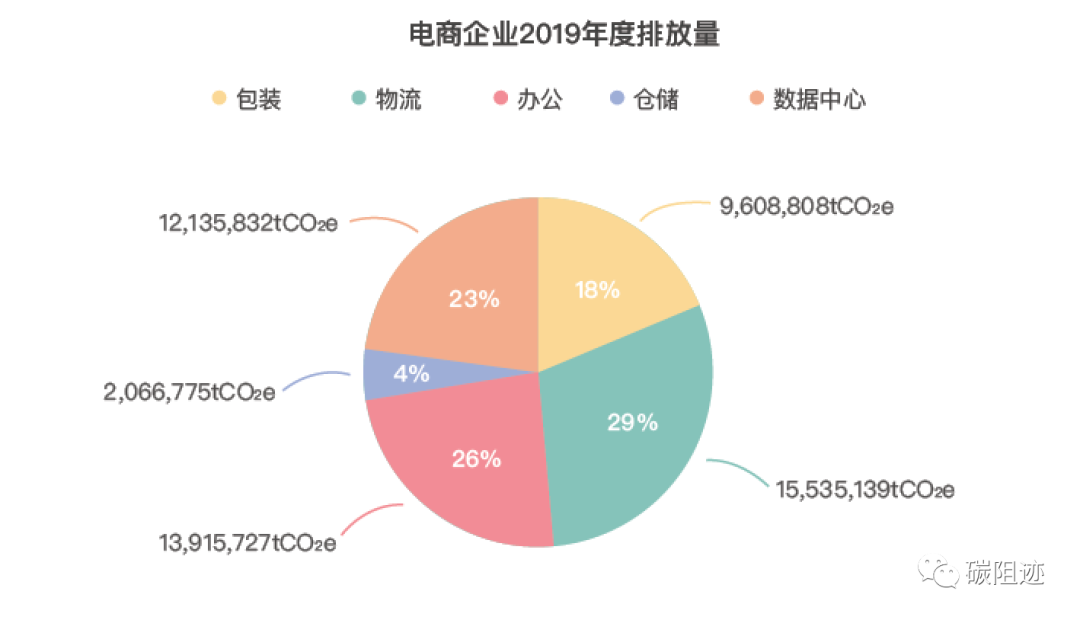
Packaging
The study found that in the packaging sector, the most significant contributor to emissions is packaging boxes, accounting for 7.65 million tons, or about 80% of packaging emissions.
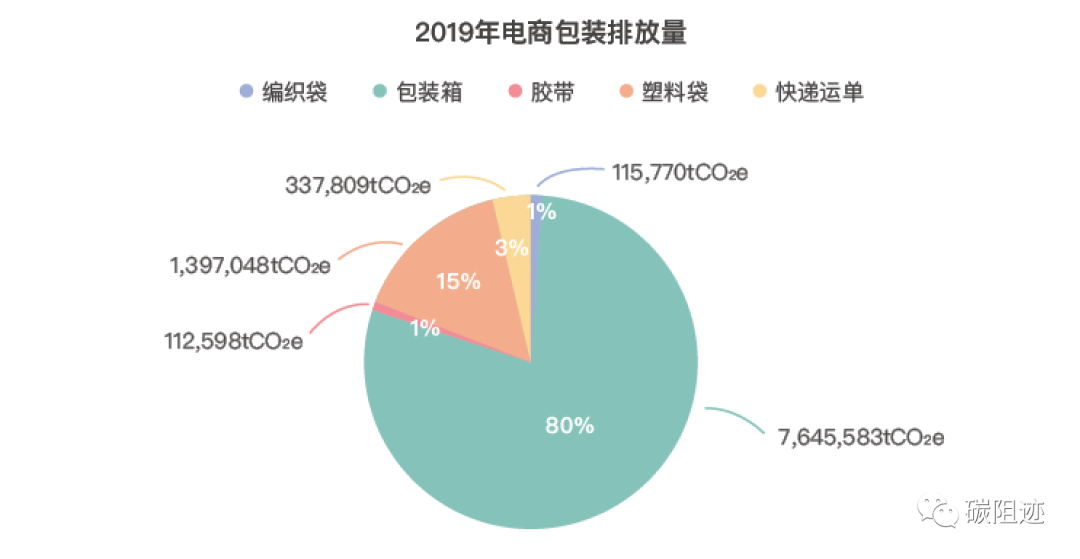
Due to measures such as woven bags, courier waybills, and tape, the proportion of emissions from packaging boxes has increased year by year, rising from 42% in 2016 to 80% in 2019.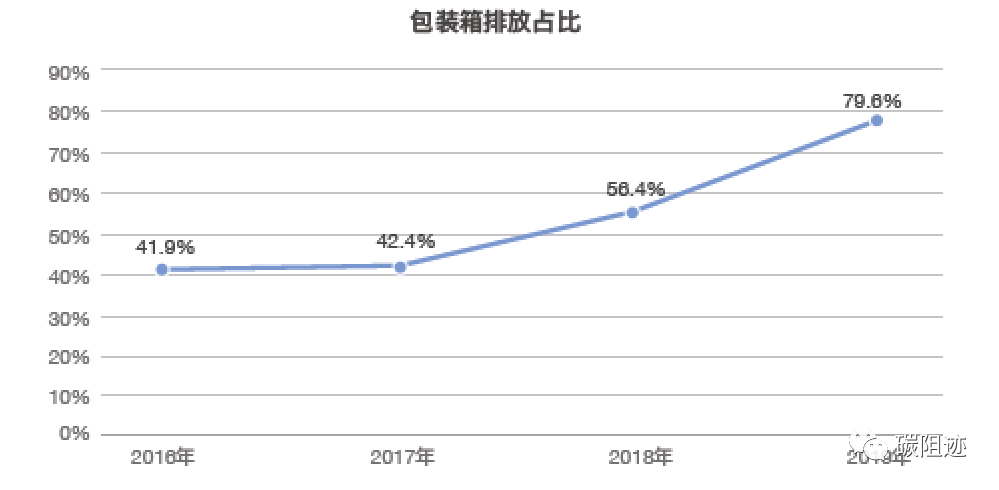
Despite many efforts by e-commerce and courier companies to reduce packaging box usage, the effects have been limited compared to other packaging materials.
Logistics
In the logistics sector, the primary focus is on emissions from road and air transport. Road transport accounts for 78% of emissions, while air transport accounts for 22%. Compared to the total emissions from the national transportation industry, e-commerce logistics emissions account for 1.6% of the total transportation emissions and 4% of freight emissions.
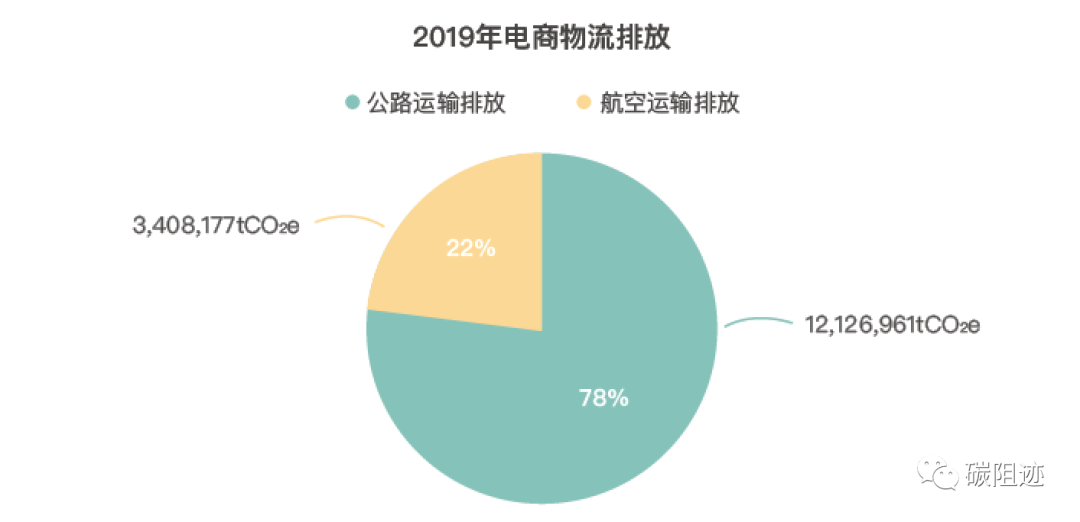
In road transport, the emissions from trunk lines, branch lines, and last-mile delivery are 77%, 22%, and 1%, respectively.
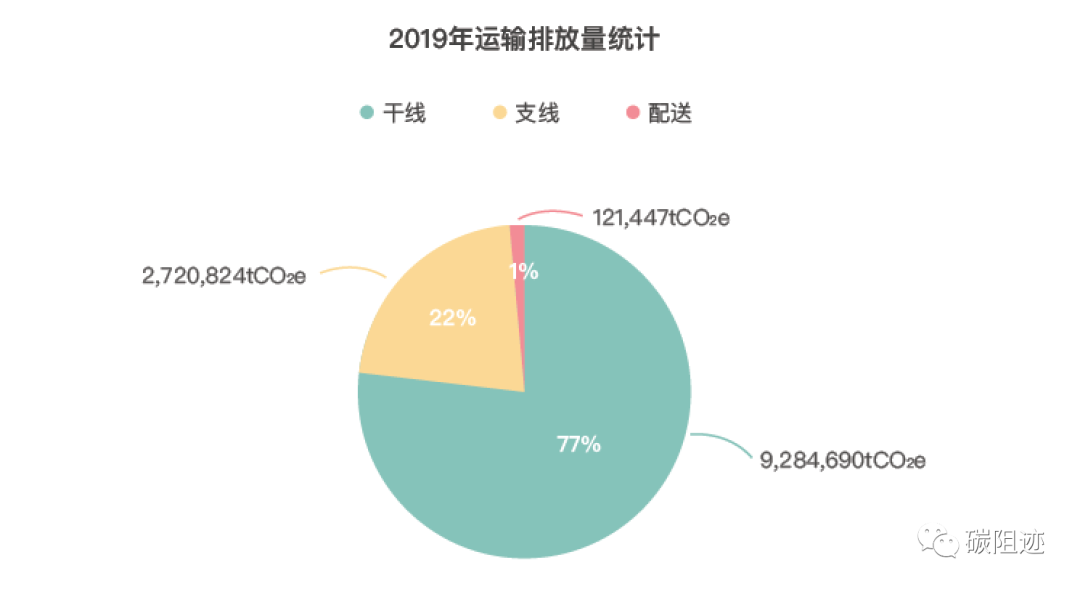
The study found that in branch line transport, diesel vehicles emit 0.49kgCO2/km, while electric vehicles emit 0.12kgCO2/km, meaning diesel vehicles emit more than four times as much per kilometer. Excluding international/Hong Kong-Macao-Taiwan routes, local and intercity logistics emissions account for 98% and 2%, respectively. Reducing emissions from trunk lines and intercity transport is a key task for e-commerce and courier companies during the 14th Five-Year Plan period.
Data Centers
In 2019, e-commerce data centers consumed 19.9 billion kWh of energy, emitting 12.14 million tons of carbon. Nationwide, data centers consumed over 200 billion kWh in 2019, with e-commerce data centers accounting for about 10% of the total energy consumption.
The following table shows the emissions from major e-commerce platforms' data centers.
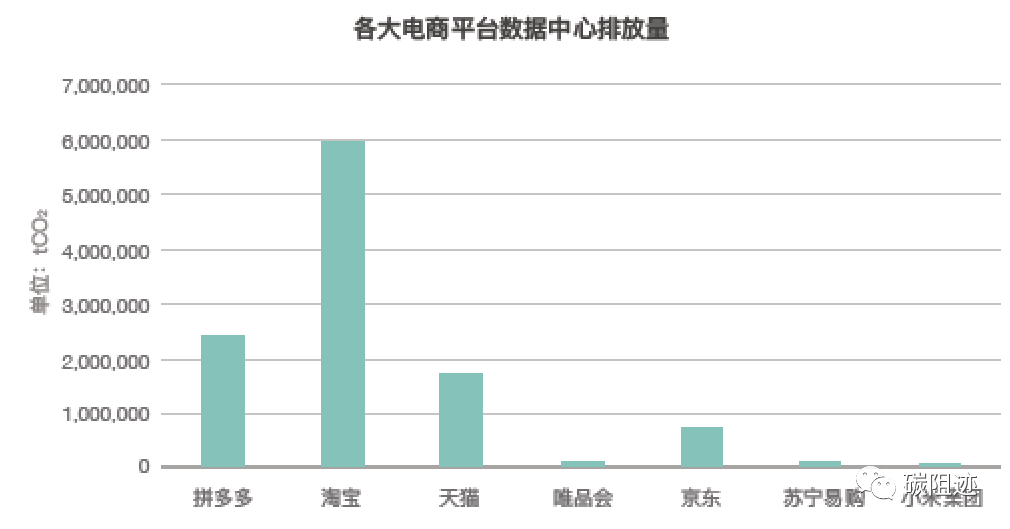
Data sourced from public information and calculations
Office Operations
E-commerce office operations generated 13.92 million tons of emissions. With the rapid development of e-commerce, the number of e-commerce employees has grown quickly. According to the Ministry of Commerce, there were 51.26 million e-commerce employees in 2019, with 31.11 million directly employed.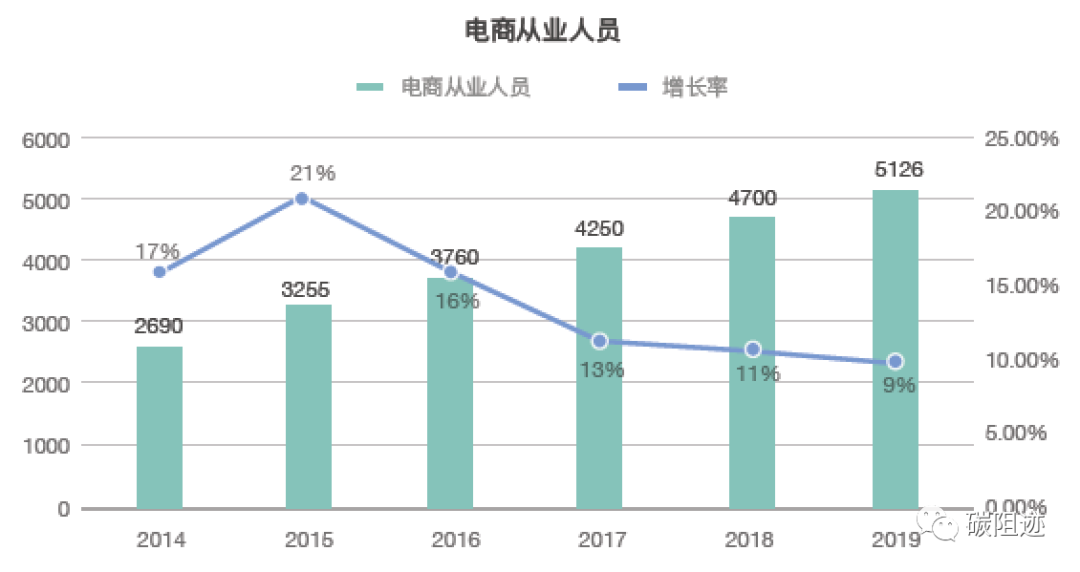
Most e-commerce companies are concentrated in coastal cities such as Guangdong, Zhejiang, Jiangsu, Shandong, and Shanghai. Guangdong has the most e-commerce companies, accounting for about 20% of the national total. Guangdong's e-commerce is the most active, with 12.872 billion packages, representing 26% of the national total. The top five provinces—Guangdong, Zhejiang, Jiangsu, Shanghai, and Shandong—account for 66% of the national package total, with 32.038 billion packages.
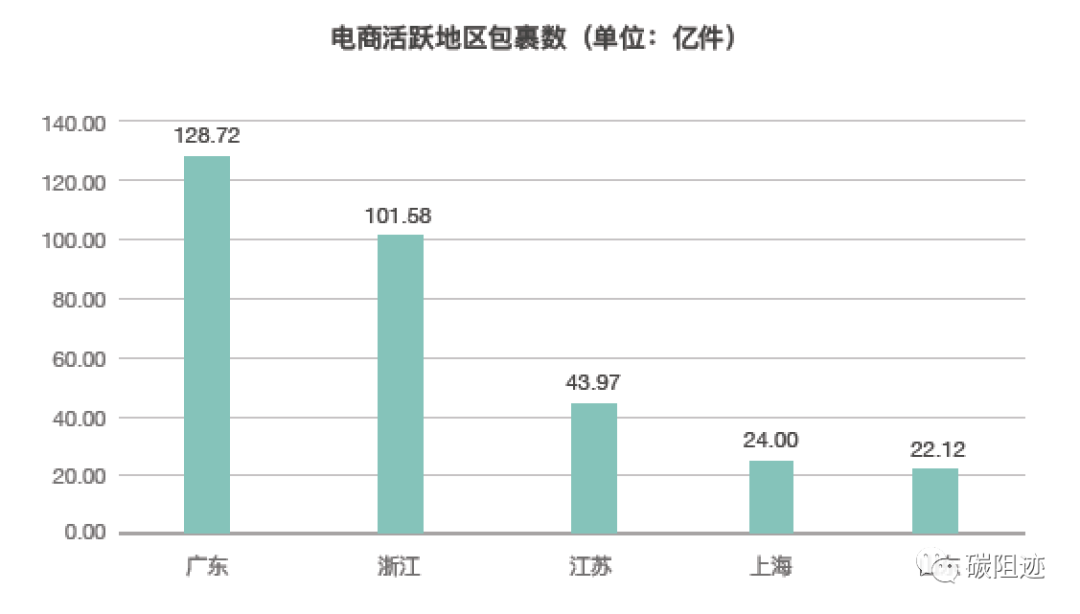
Warehousing
E-commerce warehousing generated 2.07 million tons of emissions, accounting for 2.27% of the national warehousing emissions.
Changes in E-Commerce Emissions
Based on 2019 data and information on e-commerce package volume, transaction value, and employee numbers, the changes in e-commerce emissions from 2016 to 2020 are as follows.
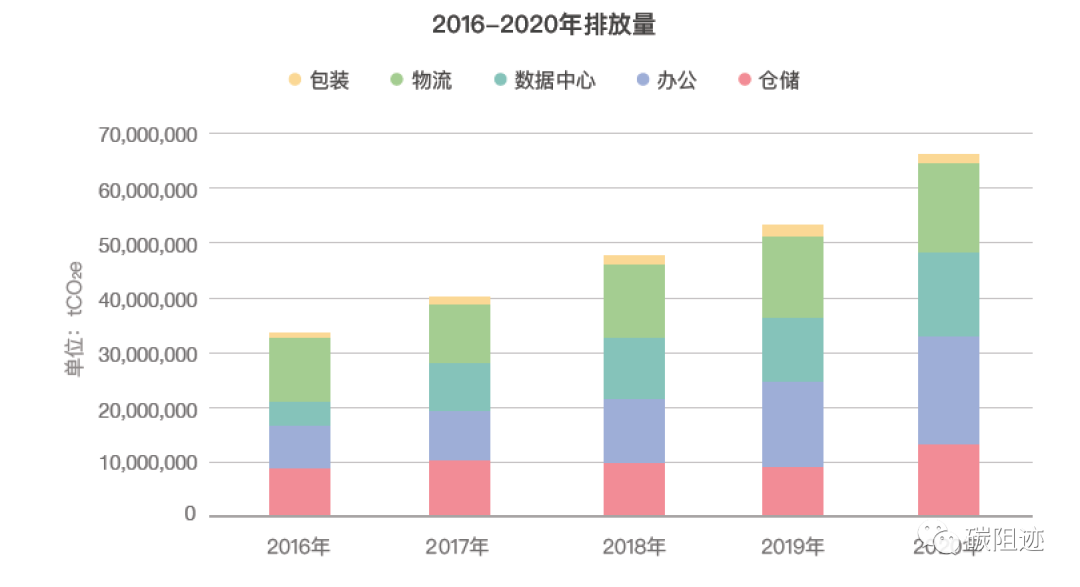
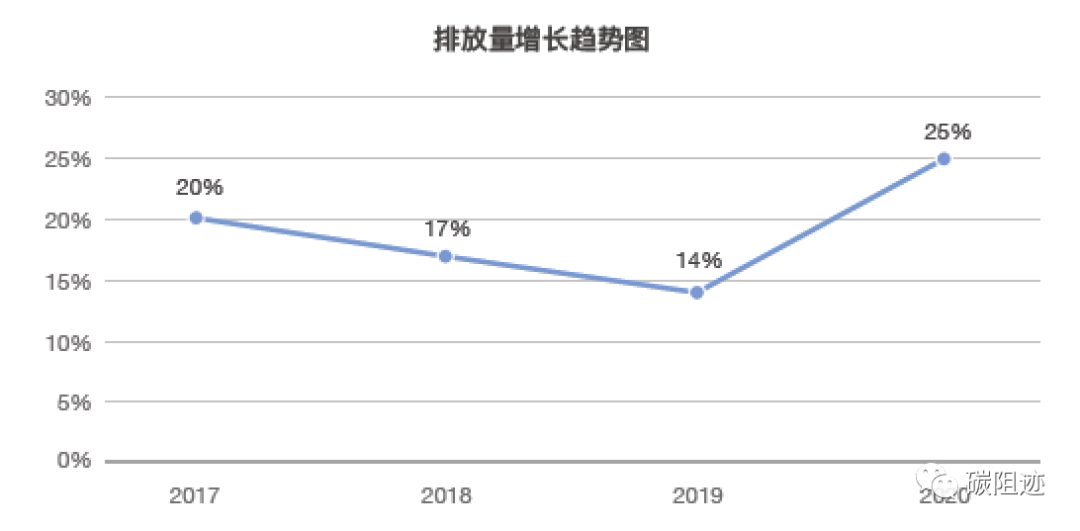
It can be seen that e-commerce emissions increased from 33 million tons in 2016 to 68 million tons in 2020, adding 35 million tons in less than five years, a 105% increase with an average annual growth rate of 21%. During the 13th Five-Year Plan period, the national carbon emissions increased by only 6%, making the growth rate of e-commerce emissions 18 times higher than the national carbon emissions growth rate.
Predicted Emissions for 2025
According to forecasts, China's courier service volume will reach 1.5 trillion pieces in 2025, an 80% increase from the over 80 billion pieces in 2020. If no relevant measures are taken, it is estimated that e-commerce companies' carbon emissions will exceed 116 million tons by 2025, accounting for 1.1% of China's total emissions in 2025. Compared to 2020, emissions will increase by approximately 50 million tons within five years, with a growth rate of 73%, and an average annual growth rate of 14.7%. According to analysis, the total expected increase in emissions during the 14th Five-Year Plan period for China is only 200 million tons, meaning that the emission increase from e-commerce companies will account for 25% of China's total increase during this period.

The proportion of emissions from data centers is expected to rise from 23% (12.14 million tons) in 2019 to 30% (34.77 million tons) in 2025, surpassing logistics to become the largest source of emissions in e-commerce.
If more ambitious emission reduction measures are not adopted, the carbon emissions generated by China's e-commerce in 2025 would require 20 billion trees to offset, meaning that achieving carbon neutrality for China's e-commerce sector would be equivalent to planting 20 billion trees.
Comparison Analysis of Online and Offline Shopping
Based on the overall study, we also compared the carbon emissions from online and offline shopping channels to see how much carbon each order corresponds to in real life and how far we are from achieving carbon neutrality. This comparison is based on one package per order.
Main Conclusions
Through comparative analysis, we have drawn the following main conclusions:
1. Based on the basic conditions outlined in the article, online shopping is more carbon-efficient than offline shopping. The carbon emissions for purchasing one item online and one item offline are 1094.92gCO2e and 1360.24gCO2e, respectively.
2. Sources of carbon emissions from online shopping include: transportation - courier delivery (approximately 29.16%), buildings - office operations (approximately 26.12%), buildings - warehousing (approximately 3.88%), information technology - data centers (approximately 22.78%), information technology - consumer device power consumption (approximately 0.02%), packaging - courier packaging (approximately 18.04%).
3. Sources of carbon emissions from offline shopping include: transportation - pre-store delivery of goods (approximately 13.03%), transportation - consumer travel emissions (approximately 35.87%), buildings - store operations (including office operations) (approximately 47.11%), packaging - plastic bags (approximately 1.05%).
4. Carbon emissions from online and offline shopping can be categorized into four main areas: transportation, buildings, information technology, and packaging. For transportation, online emissions total approximately 319.30gCO2e, while offline emissions total approximately 665.14gCO2e. For buildings, online emissions total 328.50gCO2e, while offline emissions total 684.10gCO2e. For information technology, online emissions total 249.63gCO2e, while offline emissions, which may include inventory management systems, are included in the building operation's energy consumption. Without considering the product's inherent packaging, only the additional packaging used during the shopping process, online emissions total 197.49gCO2e, while offline emissions total approximately 11.00gCO2e.
5. The calculations are based on average shopping scenarios, and the specific carbon emissions of a product are closely related to its actual journey. Specific emission values depend on factors such as product type, shipping location, courier transportation method, whether cold chain is required, actual energy consumption levels of buildings, user travel habits, and the number of orders purchased per trip.
Next, we will analyze some common products and cases in shopping.
Specific Cases
Case 1: Smartphone
Case 1: Xiao Ming, living in Daxing District, Beijing, plans to buy a new smartphone. He can purchase it from a nearby mall, go to a flagship store in the city center, or place an online order conveniently.
Electronics: Smartphone
Origin/Warehouse: Chengdu
Weight: 391g (smartphone and original packaging) + 83g (additional online packaging)
Online A: Official website order, Chengdu warehouse - distribution center - Beijing - Daxing - delivery
Online B: Self-built warehouse e-commerce, same-day or next-day delivery, Chengdu warehouse - Beijing warehouse - Daxing - delivery
Offline A: Official store - Xidan, retailer's own logistics, Chengdu warehouse - Beijing store - consumer transportation (subway or car)
Offline B: Dealer store - 1km from consumer: Chengdu warehouse - Beijing official store - dealer store - consumer transportation (walking)
Characteristics: Small size, high value
| Shopping Channel | Origin/Warehouse | Route | Trunk Line Transport |
| Online A | Chengdu | Chengdu warehouse - central distribution center - Beijing Air China distribution center - Nanfaxin transfer station - Daxing outlet - delivery | Airplane |
| Online B | Chengdu | Chengdu warehouse - Majiqiao transfer center - Daxing outlet - delivery | Truck |
| Offline A | Chengdu | Warehouse - Beijing store; Daxing - Xidan store | Truck |
| Offline B | Chengdu | Warehouse - Beijing dealer - Beijing store - Daxing - nearby | Truck |
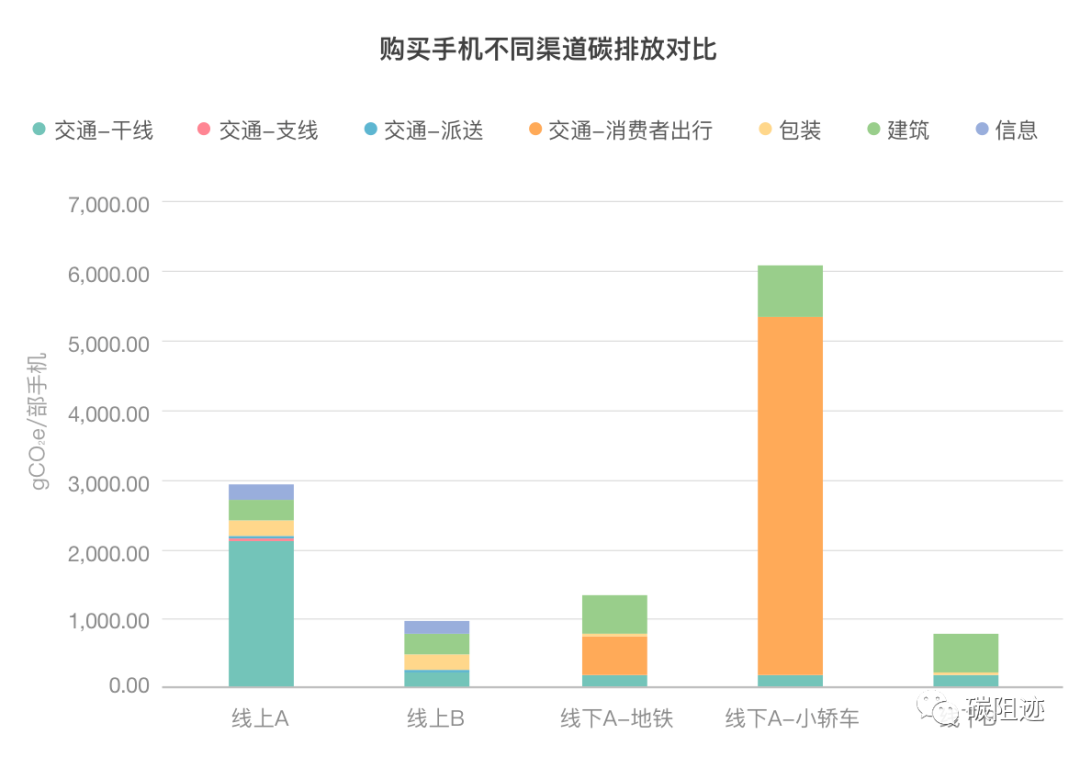
Based on the calculations, there is no absolute conclusion regarding the carbon emissions from buying a smartphone online versus offline. The emissions are ranked as follows: Offline A - car > Online A - air freight > Offline A - subway > Online B - self-built warehouse e-commerce > Offline B - walking to a nearby store.
Xiao Ming driving to Xidan has the highest carbon emissions, followed by ordering from the official website and having it air-freighted to Beijing and delivered home. Next is Xiao Ming taking the subway to the Xidan store, then placing an order through an e-commerce platform with self-built warehouses, such as JD.com, where the product is collected by truck and delivered from a nearby warehouse. The lowest emissions come from walking to a nearby mall to make the purchase.
Case 2: Hairy Crabs
Case 2: Xiao Hua, living in Haidian District, Beijing, plans to buy some hairy crabs.
Fresh produce: Hairy crabs
Weight: 1kg of hairy crabs
Origin: Suzhou
Delivery location: Haidian District, Beijing
Online: Suzhou outlet - transfer center - Beijing - Haidian - delivery (cold chain)
Offline: Suzhou - Haidian District store - consumer walking (cold chain)
Characteristics: Requires cold chain to maintain freshness
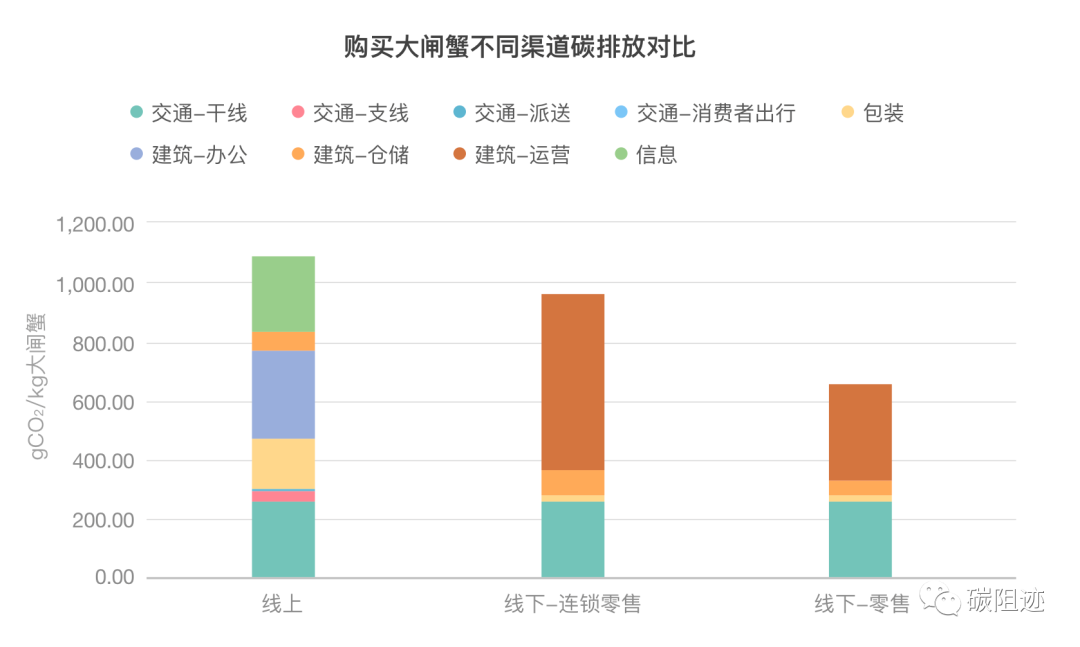
The order of carbon emissions is as follows: online > offline - chain retail > offline - retail, where offline retail includes all forms of retail, such as markets and small shops.
To purchase large crabs with the lowest carbon footprint, Xiao Hua should go to a local market or small shop. A relatively lower-carbon option would be to visit a chain retailer, like a large supermarket. The highest carbon footprint comes from purchasing online.
Case 3: Cherries
Case 3: Guo Guo, a child living in City L, Shanxi Province, loves cherries. Guo Guo's mother wants to buy some cherries for her. Guo Guo's home is very close to a supermarket, just outside their door, which can be reached on foot.
Weight: 2.5kg
Origin: Chile / Shandong
Delivery Location: City L, Shanxi Province
Online A: Origin Chile - sea freight to Shanghai - Taiyuan - City L
Online B: Origin Shandong - Taiyuan - City L
Offline A: Origin Chile - sea freight to Shanghai - Taiyuan - City L
Offline B: Origin Shandong - Taiyuan - City L
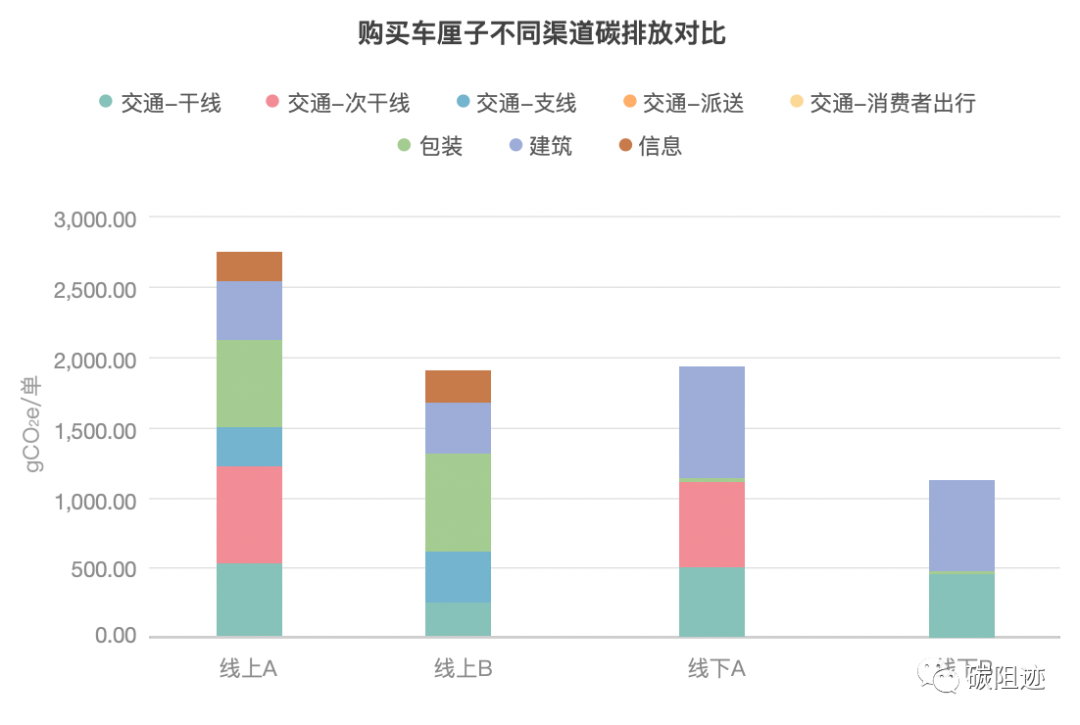
In terms of overall carbon emissions, the ranking is: buying imported cherries online > buying domestic cherries online ≈ buying imported cherries offline > buying domestic cherries offline.
For Guo Guo's mother, the lowest carbon emission option is to buy domestic cherries from a physical store, while the highest carbon emission option is to order imported cherries online.
Case 4: Cross-border Purchase - Tote Bag
Case 4: Xiao Mei, living in Nanshan District, Shenzhen, wants to buy a tote bag as a treat for herself. Currently, e-commerce websites and offline platforms are offering discounts, and the overseas official website is also having a sale. Xiao Mei wants to place an order quickly.
Weight: 1.8597kg
Origin: Cambodia
Delivery Location: Nanshan District, Shenzhen
Online A (Cross-border Line 1): Origin Cambodia - order placed on U.S. official website - Portland transfer - fly to Guangzhou - Nanshan
Online B (Cross-border Line 2): Origin Cambodia - friend orders on U.S. official website - friend mails via sea freight - Shanghai - Shenzhen - Nanshan
Online C (Domestic E-commerce Line): Origin Cambodia - Suzhou - Shenzhen - Nanshan - delivery
Offline Domestic Physical Store: Origin Cambodia - Suzhou - Shenzhen - consumer transportation (average level)
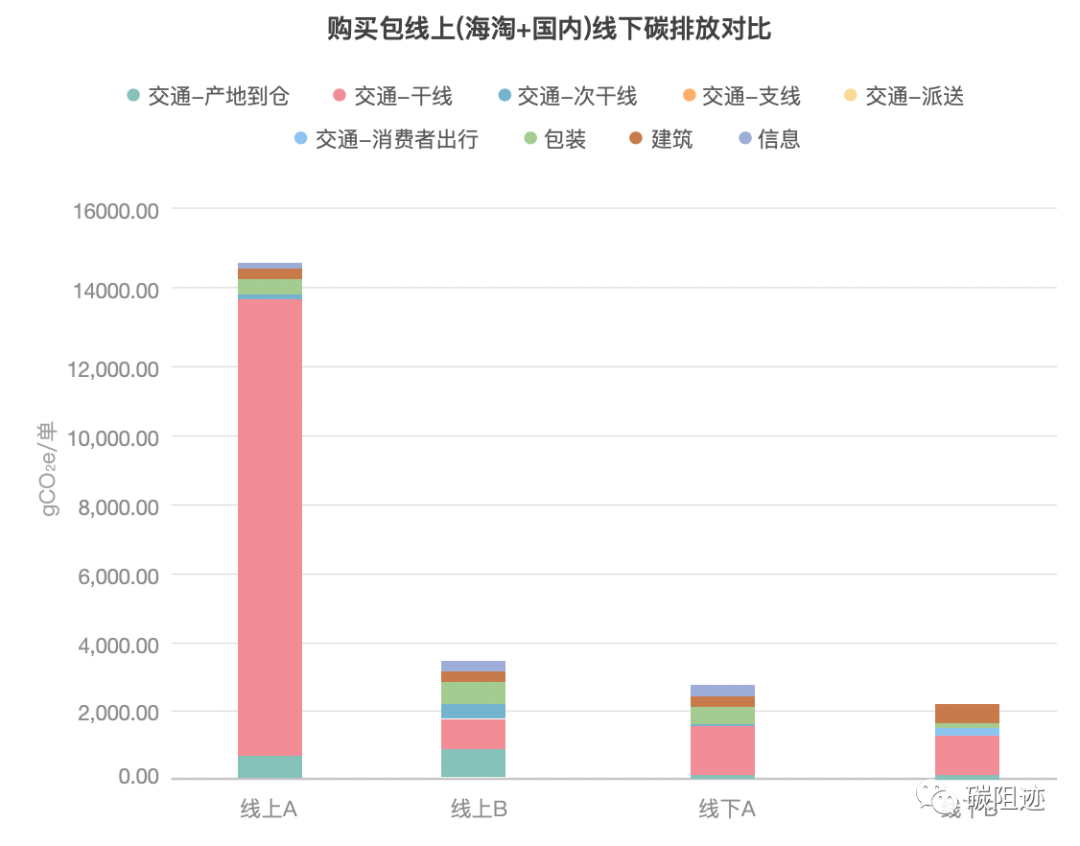
The order of carbon emissions from highest to lowest is: Online A > Online B > Online C > Offline.
For Xiao Mei, the lowest carbon footprint option is to buy the tote bag from a physical store, while the highest carbon footprint option is to use cross-border shipping (air freight). Cross-border purchases have higher emissions due to the longer distance traveled, especially when the product goes from Cambodia to the U.S. and then to China, compared to a direct route from Cambodia to China.
Another calculation considering both domestic transport and U.S. research results shows a similar trend.
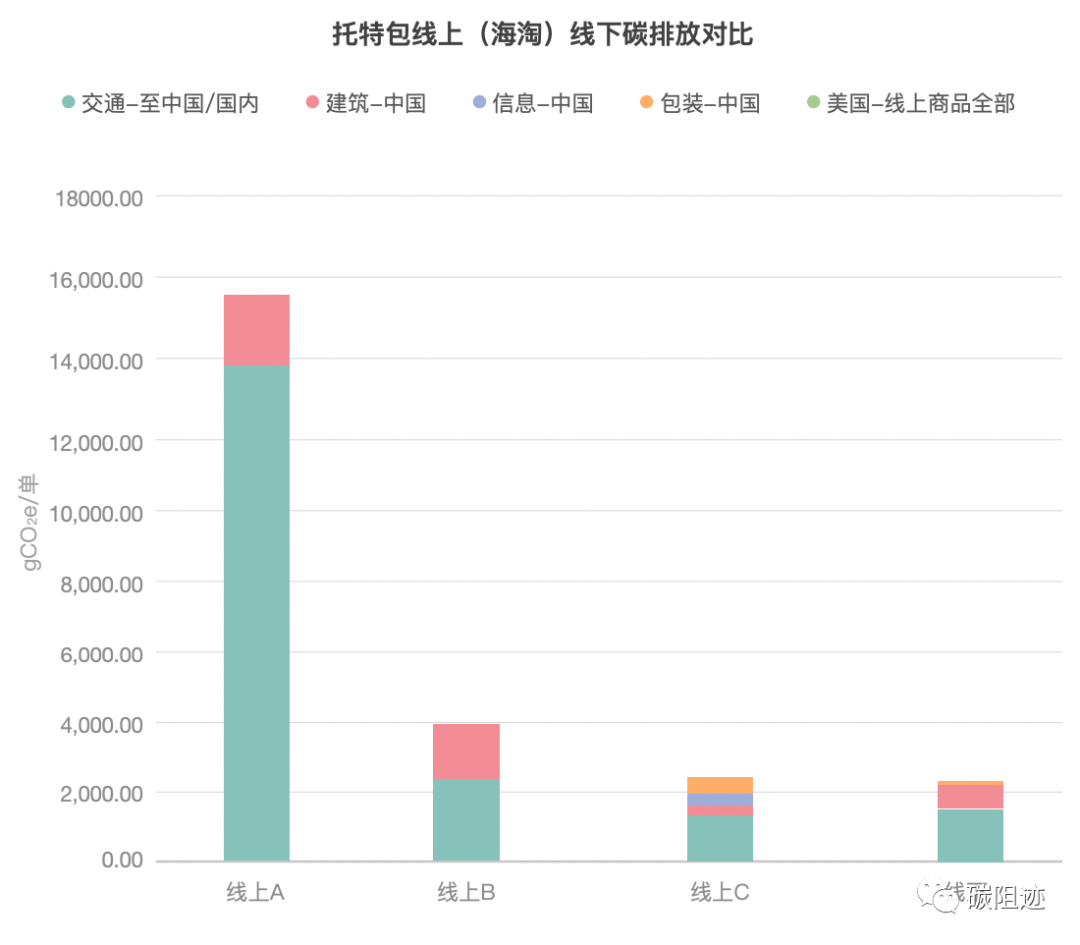
Case 5: Digital Accessories
Case 5: Xiao Yong, located in Donghu District, Nanchang, Jiangxi, buys phone cases from the Yangtze River Delta and Pearl River Delta. What is the difference in carbon emissions? As a small stall owner, he wants to know if ordering directly online can be more carbon-efficient.
Weight: 0.15kg + 0.02kg bubble wrap packaging + 0.05kg plastic packaging shell; regardless of whether it's online or offline, there is always a plastic packaging shell.
Shipping Location: Yangtze River Delta (Hangzhou, Zhejiang) / Pearl River Delta (Guangzhou, Guangdong)
Delivery Location: Donghu District, Nanchang, Jiangxi
Online A: Hangzhou - Nanchang transfer - Donghu District outlet
Online B: Guangzhou - Nanchang transfer - Donghu District outlet
Offline A: Hangzhou - Nanchang wholesale market - Donghu District store
Offline B: Guangzhou - Nanchang wholesale market - Donghu District store
In this case, all four scenarios involve consumers located in Donghu District, Nanchang. Online A and B refer to purchasing phone cases from the Yangtze River Delta and Pearl River Delta, respectively. Offline A refers to wholesalers purchasing phone cases through online platforms and selling them offline, while Offline B refers to wholesalers shipping directly from manufacturers to stores via the shortest route.
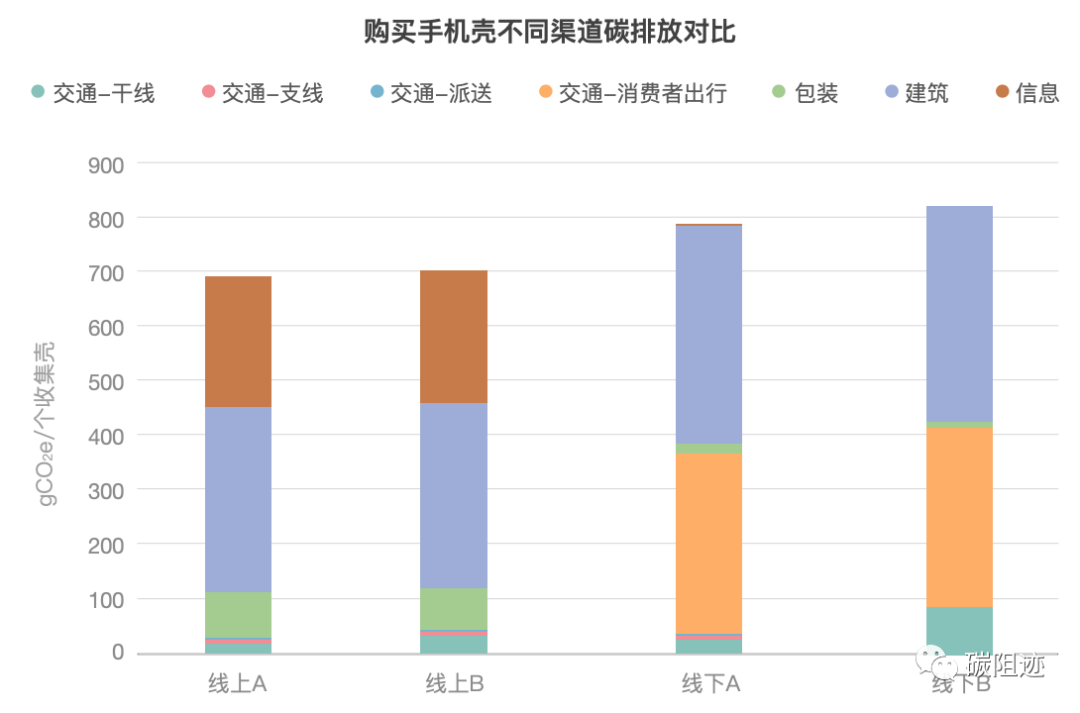
The overall carbon emissions ranking is: Offline B > Offline A > Online B > Online A.
For Xiao Yong, placing an online order with the closest origin (Pearl River Delta) results in the lowest carbon emissions. There is no significant difference between ordering from the Pearl River Delta or the Yangtze River Delta, except for the transportation distance. For the offline part, small retailers can reduce average packaging and information consumption per item by using online bulk purchasing, even though it adds some building emissions. However, the total emissions are still lower than those from traditional wholesale.
Low-Carbon Recommendations
After the study, we also provided some low-carbon recommendations for consumers, e-commerce, and traditional businesses.
Consumers
- The distance of transportation emissions is not just the distance I've walked or seen.
Consider the origin of the products when shopping online; choose nearby stores for offline shopping or opt for lower-carbon travel methods; prefer domestic and local products to reduce carbon emissions and pandemic risks.
- Not all fast deliveries necessarily mean high emissions, but being patient can lead to unexpected low-carbon benefits.
High-speed deliveries may come from air freight or pre-positioned local warehouses. While the result for consumers is the same, the emission processes differ. If consumers are willing to wait, using land transport instead of air freight or waiting for trucks to be fully loaded can significantly reduce carbon emissions.
- Your choices can drive businesses toward low-carbon efforts.
Carbon emissions are becoming an important indicator of a brand's or company's environmental performance. By choosing companies that manage and disclose their carbon emissions, consumers can drive supply chain transformation towards lower emissions.
E-commerce
- Platforms have responsibility and control, making low-carbon information clearer.
E-commerce platforms with self-operated logistics should use big data and smart analytics to deploy regional warehouses, ensuring high efficiency while reducing transportation emissions. Platforms and suppliers should provide more transparent product traceability information to help consumers make informed choices. Platforms should actively improve energy efficiency and increase the use of renewable energy in offices and data centers. E-commerce platforms should actively disclose and manage their carbon emissions.
- Merchants have choices and responsibilities, saving costs while reducing emissions.
Specialty merchants can offer hybrid online-offline models, shipping from the nearest store or warehouse. They can also give consumers the option to wait for lower-emission delivery methods, such as land transport or rail, especially for shorter distances within the country. Merchants can also optimize packaging by reducing excessive packaging, using appropriately sized boxes, and opting for thinner tape. Choosing carbon-disclosed packaging and logistics providers can help track and disclose relevant information to consumers.
- Greener courier logistics, with electric vehicles playing a key role.
E-commerce platforms and online merchants have more control over their logistics. Self-operated logistics platforms and companies can gradually switch to lower-emission electric vehicles. Small and medium-sized electric trucks can reduce carbon emissions by more than 50% compared to diesel and gasoline vehicles. Platforms should also focus on green and reusable packaging materials.
Traditional Retail
- Adopt an open attitude to integrate online and offline, reducing consumer travel emissions.
In the carbon emissions of offline shopping, consumer transportation is a significant variable. Traditional retailers can offer delivery options, such as couriers or in-store delivery, to provide consumers with lower-carbon choices. For example, delivery by couriers can reduce CO2e emissions by 1.19kg per 5km compared to driving to the store.
- Energy efficiency upgrades to reduce emissions.
The main source of emissions for traditional retail is building energy consumption, particularly for large supermarkets, malls, convenience stores, and specialty stores. Retailers should strive to reduce energy consumption per square meter by adopting energy-saving technologies, such as LED lighting, variable frequency air conditioning, and intelligent control systems. Using more efficient display cabinets and refrigerators can also help reduce emissions.
- New store locations to create low-carbon advantages.
Traditional retailers should consider locating stores closer to target consumers to reduce travel emissions. A 15-minute living circle can bring stores closer to residents and promote greener transportation options, such as public transit. New store locations can also leverage local advantages, such as green buildings that use natural light and renewable energy sources like solar power, to minimize building emissions from the outset.
![[Original Carbonstop] How far is China's e-commerce from carbon neutrality](/_next/image?url=https%3A%2F%2Ffactor-file.carbonstop.com%2Ffactor-test%2Fc544ff8711224eb69b7146b8d64b0d4f852.png&w=1920&q=75)